Louisiana may be famous for Mardi Gras, Cajun food, and the bayous where alligators lurk, but there are forests and rolling plains that you can also explore. Throughout the “Pelican State,” snakes make their homes in the most humble of locations – quiet little nooks and crannies, and even under rocks and debris piles.
We did some digging and found Louisiana’s most common snakes. Most of them are nonvenomous and harmless to people, but the state is home to a few venomous danger noodles too.
Before we get to the identification tips, we’d like to warn you: Don’t touch a snake unless you’re 150% positive of its identification. Like any good snake hunter, we think it’s important to figure out whether a snake is actually dangerous before you panic. So, let’s start with those.
Most Common Venomous Snake in Louisiana: Northern Cottonmouth (Agkistrodon piscivorus)
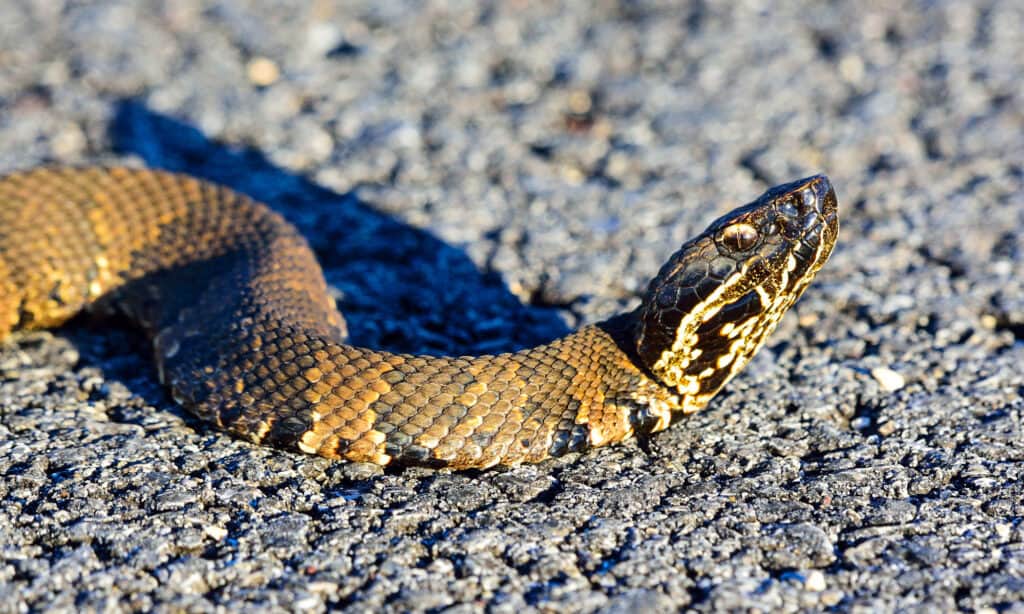
Cottonmouths are venomous snakes.
©Ad Konings/Shutterstock.com
Cottonmouths are also called water moccasins, and the myth is that they’ll chase you. Yes, it’s a myth. Snakes don’t chase people. If you harass one enough, it will bite as a last resort, possibly injecting venom.
Far from the aggressive, mean snake that you may expect to find, the cottonmouth doesn’t actually want anything to do with you. These snakes are about two to four foot long, heavy-bodied pit vipers that live in areas with access to fresh water. Cottonmouths’ chunky bodies taper dramatically from the end of the body to the end of the tail. Like all pit vipers, they have big, triangular heads and fairly narrow necks. Their heads are huge because they house the venom glands that are attached to moveable, hinged fangs.
Their body pattern varies according to age and location. Juveniles are frequently mistaken for copperheads because their markings are very similar. Many of them have an hourglass pattern that looks like chocolate kisses from the side. However, cottonmouths’ pattern edges are more ”pixelated” in appearance, and they lack the smooth gradients that copperheads possess. As cottonmouths age, they become darker, and the pattern becomes more difficult to spot. They range from dark, dark brown to olive, and some are almost completely black.
Their heads have dark stripes along the sides. These stripes often have a lighter border color; they have sharp angles around their snout, lower jaw, and head. They also have a sort of ”ticked off” look because cottonmouths and most other pit vipers have an extra scale over their eyes. Some believe the extra scale works like sun protection for their eyes.
Defensive Behavior
It’s in their defensive behavior that you see why people call them ”cottonmouth” snakes. Most of the time, they’ll either avoid you or sit completely motionless, hoping you don’t see them. They’re slow-moving and not very elegant on the land. However, when they realize that the jig is up and you’re still there, they gape their mouths and show the cotton-white mouth and hollow fangs. It’s also this behavior that makes people think they’re aggressive.
Yet, they’re not. Some reports say that they’re quicker to bite than their close cousins the copperheads; certainly, if you continue to harass the snake and it bites, it will hit you. They have one of the fastest strikes in nature at just under 10 feet per second (2.95 m/s). While these snakes are slow on land, they’re fast and elegant in the water. Cottonmouths simply more comfortable in the water, so they can be highly defensive on the land.
Other Venomous Snakes in Louisiana
While cottonmouths may be the most commonly encountered venomous snake in Louisiana, they’re far from the only danger noodle in the state. Eastern diamondback rattlesnakes are probably more dangerous than cottonmouths, just for the sheer volume of venom injection. However, they’re not as common.
- Timber rattlesnake (Crotalus horridus)
- Eastern copperhead (Agkistrodon contortrix)
- Western pygmy rattlesnake (Sistrurus miliarius)
- Eastern diamondback rattlesnake (Crotalus adamanteus)
- Eastern coral snake (Micrurus fulvius)
- Texas coral snake (Micrurus tener)
Non Venomous Snakes in Louisiana
The cottonmouth is fairly easy to identify, but it’s often confused for various nonvenomous water snake species like the next one on our list.
1. Banded Water Snake (Nerodia fasciata)
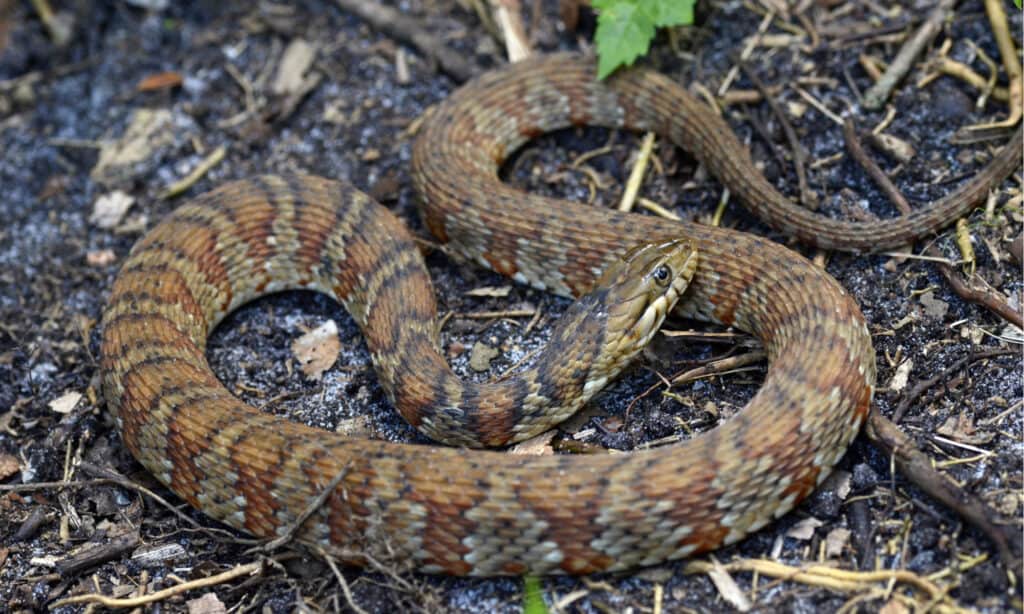
Banded water snakes are heavy-bodied with flat heads.
©Patrick K. Campbell/Shutterstock.com
If you’re near fresh water in Louisiana, you’ve got a solid chance of seeing a banded water snake. The difference between how a water snake swims and a cottonmouth isn’t enough to positively identify them. There are just too many variables that can affect how they’re swimming at that moment.
In general, banded water snakes are heavy-bodied with flat heads measuring about two to four feet long, which unfortunately adds to their misidentification woes. However, their bodies taper very gradually toward the tail, and you can properly identify them using a couple of key identifiers. In order to do this, you need to eliminate the venomous cottonmouth as a suspect.
Banded water snakes are usually brown, gray, or greenish-gray with dark cross bands that can vary from reddish brown to brown. Some individuals become so dark that you can’t see their patterns. Unfortunately, many cottonmouths are similarly dark, adding to the identification difficulty. Like the cottonmouth, they’re more comfortable in the water and move better there; however, these snakes are more likely to run from you than stop moving.
2. Diamondback Water Snake (Nerodia rhombifer)
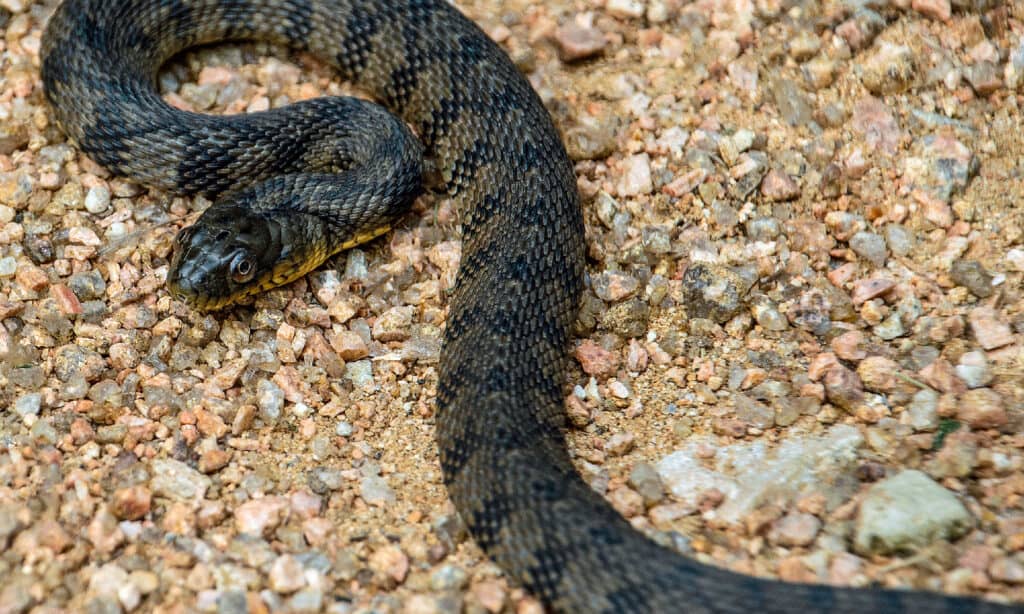
The diamondback water snake lives only in freshwater.
©iStock.com/williamhc
Like its cousin the banded water snake, diamondback water snakes are heavy-bodied; they can reach four feet in length and give live birth. However, their name gives you a hint as to their patterning. They are usually brownish with darker diamond-shaped markings on their back. Their pattern almost looks like chain links.
Diamondback water snakes are more likely to be ”vigorously defensive” and will probably bite if you try to handle them. They have extremely sharp teeth that make their bite quite painful, but there’s no venom in it. They also won’t be polite and show you their pretty fangs and white mouth first.
This species is often a victim of mistaken identity because the diamond-shaped markings are somewhat reminiscent of rattlesnakes. However, rattlesnakes don’t hang off branches over the water while they wait for a fish to swim close enough to reach. Rattlesnakes hide in the brush waiting for rodents.
3. Western Ribbon Snake (Thamnophis proximus)
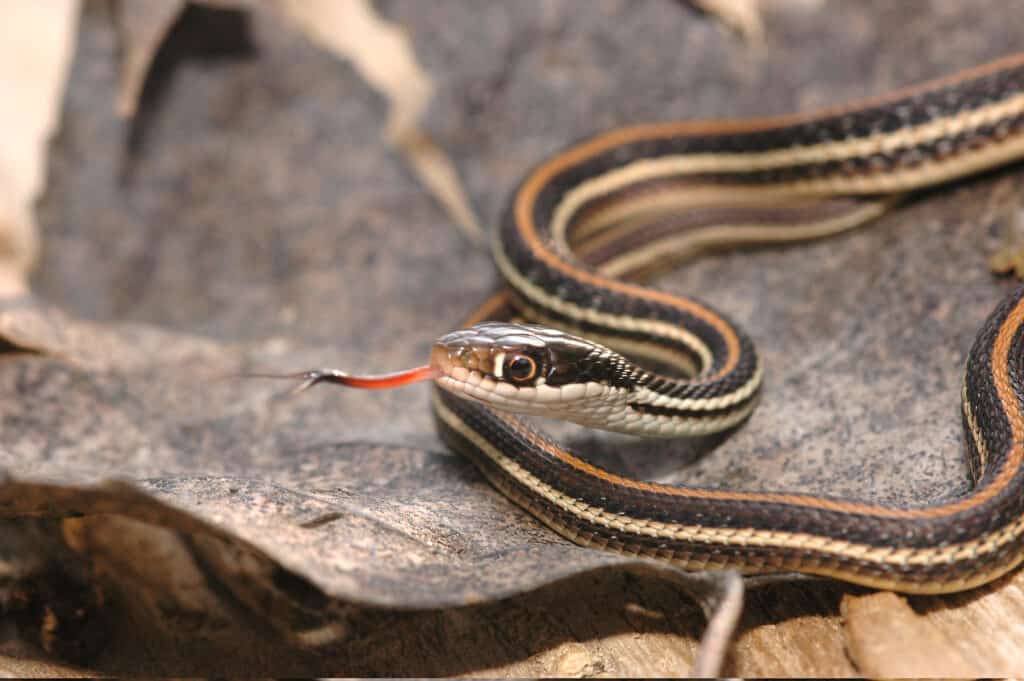
The western ribbon snake has three light stripes that start just behind the head and extend all the way down the body.
©iStock.com/Shoemcfly
You had to know some sort of garter or ribbon snake would be here. Ribbon snakes are a type of garter snake. They are common across North America and in southern Canada.
The western ribbon snake, contrary to its common name, occurs in the central regions of North America. It’s a quick snake, and measures anywhere between a foot and a half long to a little over four feet long. Like most in the Thamnophis genus, it has largish, friendly eyes with round pupils. Its body is long and slender with a dark base color that can vary from olive to black. This species has three light stripes that start just behind the head and extend all the way down the body. On its head is a spot that looks like two spots merged together. Its belly is either greenish or yellowish-white, and it doesn’t have any markings around its lips.
Garter snakes are equally at home on the land as they are swimming through ponds. They eat many small amphibians, so they tend to stay close to the food. This species is completely harmless to people.
4. North American Racer (Coluber constrictor)
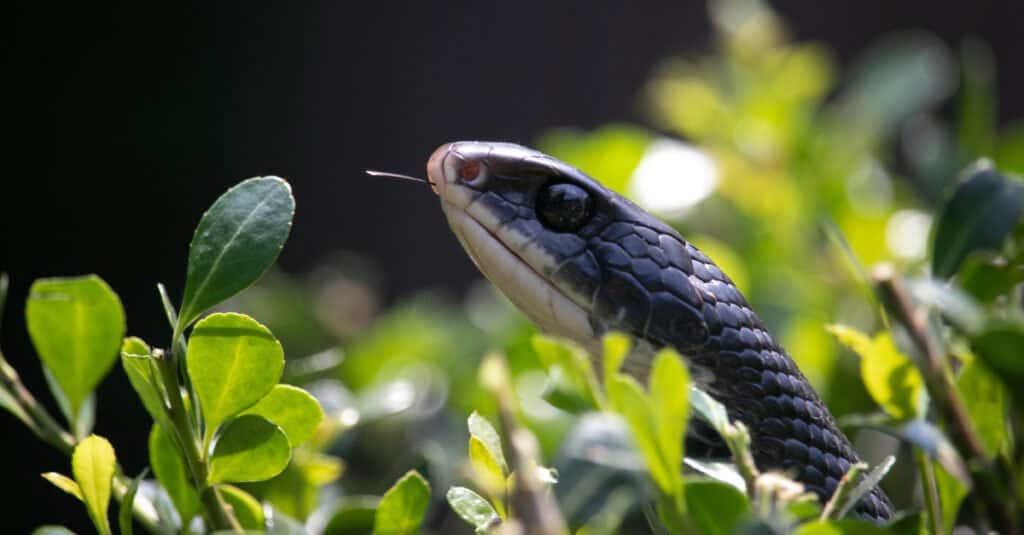
The southern black racer is also commonly known as the North American racer.
©TjacksonVii/Shutterstock.com
Racers are great snakes that move so fast they may be gone before you see them. While there isn’t a lot of information on how fast other snakes travel per hour, we do have measurements for racers. Their top speed cruising across the land is about four miles per hour. That doesn’t seem very fast, but for a snake, it’s a pretty good clip. Racers measure up to about five feet long as adults but don’t weigh much because they’re so thin. These colubrids are nonvenomous, but if you corner one, they’ll thrash around like their tail’s on fire. Try to pick it up, and they will bite.
Racers are long, slender snakes that cruise through the trees and the underbrush during the day, looking for rodents, small lizards, amphibians, and even birds’ eggs from time to time. Although constrictor is in their scientific name, they don’t actually constrict their food. They hold on tightly with their mouths and pin them against the ground or a rock with a coil or two until it stops struggling.
Depending on the subspecies, their dorsal side varies from olive to black or blue-black, and their belly or ventral side ranges from creamy-white to yellow. They have a fair amount of white on their chin and necks, but not as much as a rat snake. Juvenile North American racers look similar to rat snakes, and people often confuse the two.
Other Louisiana Snakes
While our list contains the most common Louisiana snakes, there are quite a few other snake species in the state. Aside from the venomous danger noodles we listed earlier, you might see the following snakes:
- Mudsnakes: Rainbow snakes and red-bellied mudsnakes
- Kingsnakes: Six species, including the speckled kingsnake (Lampropeltis holbrooki)
- Corn and Rat snakes: These snakes are all in the Pantherophis genus.
- Brown snakes: Dekay’s brownsnake is extremely common, and many people mistake it for almost any other species.
- About a dozen other nonvenomous snakes occur in Louisiana including coachwhips, rough greensnakes, and eastern hognose snakes.
The ”Snake Chased My Friend” Myths
Despite what you may have heard about this or that snake chasing someone, it doesn’t happen. Many snakes are naturally curious and will come up to you if you don’t appear threatening. This isn’t chasing. Cottonmouths sometimes swim toward boats out of curiosity, then keep moving. Coachwhips periscope up and come check people out.
Keep in mind that most stories include a venomous snake. It’s also almost never a first-hand account. Why? Because people are afraid of what venomous snakes can do, and rightly so! The venom they can inject causes everything from mild irritation to tissue necrosis, paralysis, internal bleeding, and death.
However, these snakes aren’t out to get you. In fact, we’re not on any snake species’ regular menu, and except in very rare circumstances, even the giant snakes would rather avoid you. Yes, there are credible instances where a 20+ foot python or anaconda made the news because somebody found a person in its belly. The fact that they make the news when this happens tells you how uncommon it is. If it were commonplace, it probably wouldn’t be reported with as much shock and awe.
If you give it space, most of the time the snake goes along its merry little way and never bothers you. Of course, if you have children and pets in the yard, then a venomous snake needs to be relocated. There are numerous companies happy to do that for you – and many volunteers who are comfortable handling these animals who won’t charge a penny.
Up Next
The photo featured at the top of this post is © Linda Burek/Shutterstock.com
Discover the "Monster" Snake 5X Bigger than an Anaconda
Every day A-Z Animals sends out some of the most incredible facts in the world from our free newsletter. Want to discover the 10 most beautiful snakes in the world, a "snake island" where you're never more than 3 feet from danger, or a "monster" snake 5X larger than an anaconda? Then sign up right now and you'll start receiving our daily newsletter absolutely free.
Thank you for reading! Have some feedback for us? Contact the AZ Animals editorial team.






